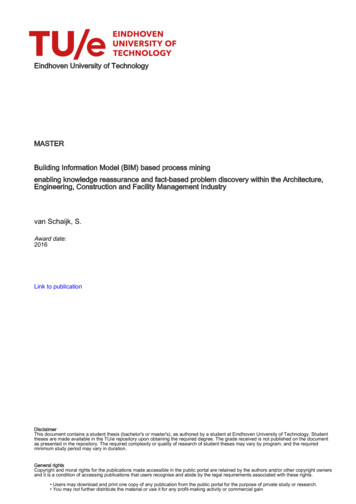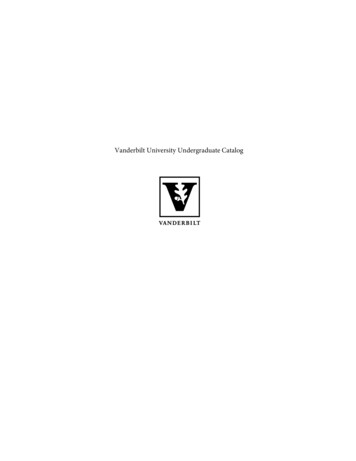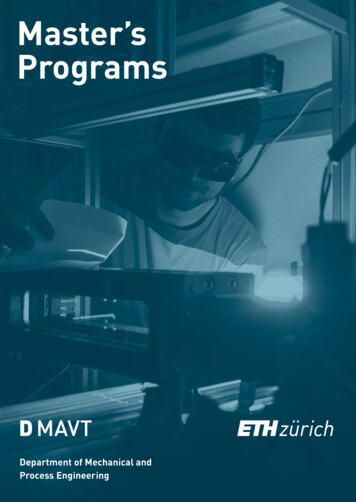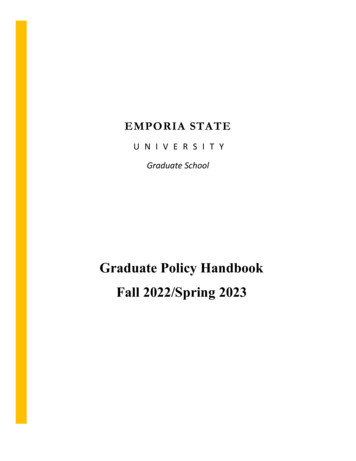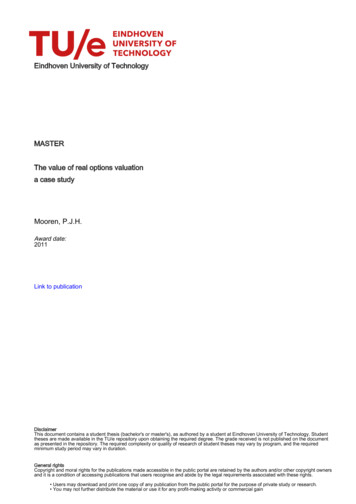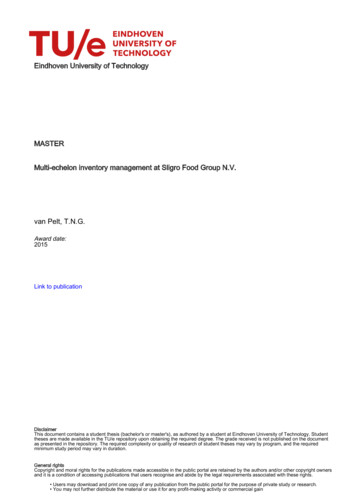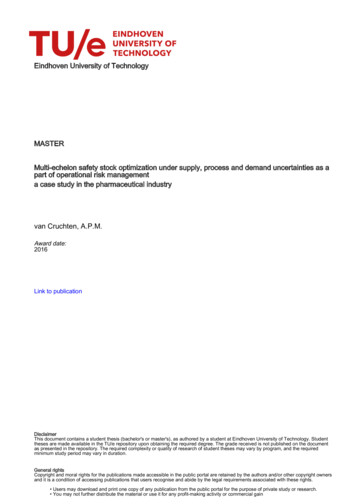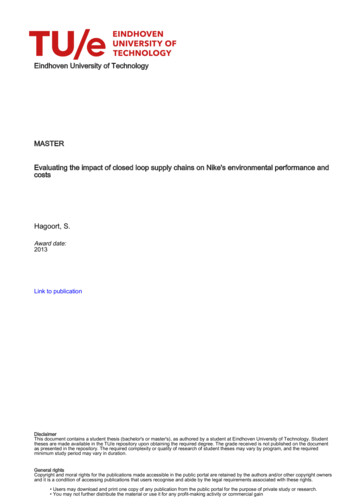
Transcription
Eindhoven University of TechnologyMASTEREvaluating the impact of closed loop supply chains on Nike's environmental performance andcostsHagoort, S.Award date:2013Link to publicationDisclaimerThis document contains a student thesis (bachelor's or master's), as authored by a student at Eindhoven University of Technology. Studenttheses are made available in the TU/e repository upon obtaining the required degree. The grade received is not published on the documentas presented in the repository. The required complexity or quality of research of student theses may vary by program, and the requiredminimum study period may vary in duration.General rightsCopyright and moral rights for the publications made accessible in the public portal are retained by the authors and/or other copyright ownersand it is a condition of accessing publications that users recognise and abide by the legal requirements associated with these rights. Users may download and print one copy of any publication from the public portal for the purpose of private study or research. You may not further distribute the material or use it for any profit-making activity or commercial gain
Eindhoven, September 2013Evaluating the impact of closedloop supply chains on Nike’senvironmental performance andcostsBy Sander HagoortBSc Industrial Engineering – TU/eStudent identity number 0658930in partial fulfilment of the requirements for the degree ofMaster of Sciencein Operations Management and LogisticsSupervisors:dr. T. Tan, TU/e, OPACdr.Y. Bouchery, TU/e, OPACAad Ramondt, Nike, Program Manager Supply Chain Innovation
TUE. School of Industrial Engineering.Series Master Theses Operations Management and LogisticsSubject headings: supply chain management, transportation, life-cycle characteristics, carbondioxide emissionsII
AbstractIn this master thesis project the impact of closed loop supply chains on environmentalperformance and costs is assessed. A framework is developed in order to help decision makingon closing the loop in Nike’s supply chain. This framework is used to assess the environmentaland cost impact of several scenarios with different recycling processes and network designs.III
AcknowledgementIn this report the results of my master thesis project of the master program OperationsManagement and Logistics are presented. The research project has been carried out at Nike’sEuropean Headquarters in Hilversum.First I would like to thank my supervisor at Nike. Aad Ramondt is project manager at Nike. Iwould like to thank you for all your time and interest spent in the project, the many practicalinsights given, and for involving me in all the relevant meetings. I also thank all the other peopleat Nike for their interest in this project, their answers to my questions and for a nice workenvironment.At the university I would like to thank Tarkan Tan for given me the opportunity to do thisproject under his supervision. Your guidance throughout the project, your valuable insights, andalways being available when needed is much appreciated. I would also like to thank my secondsupervisor, Yann Bouchery, fur his useful feedback and opinion.Also people not directly involved supported me. I want to thank my family and friends for theirinterest in this project, and their confidence in me. My final thanks go to my girlfriend. Thankyou for your never ending support and for always being there for me.Sander HagoortEindhoven, September 2013IV
Management SummarySustainability is an important part of Nike’s business strategy. Sustainable thinking is included indecisions made for the future. One of the sustainable initiatives within Nike is the recycling ofapparel, creating a closed loop supply chain. Closed loop supply chains give the opportunity touse more environmental friendly materials, and to use the post-consumer waste created. Inorder to maximize this possible benefit, this project evaluated the CO2 emissions, energy useand the cost impact created by transportation and recycling processes in such a closed loopsupply chain.Research DesignThe following research question and sub-questions are stated in this project:How can the impact of closed loop supply chains on environmental performance and costs bedetermined?-How can the environmental performance be determined?What is the environmental performance of current yarn supply chains?How can the impact of recycling processes on the environmental and cost impact bedemonstrated?How can a closed loop supply chain network be designed and what is the impact onenvironmental performance and costs?In this project the apparel category of Nike is considered for closed loop recycling. Apparel ismade of few materials, often cotton or polyester. The technology for closed loop recycling ofthese materials is available, and consumers in Europe are used to donate post-consumerclothing. Energy use and CO2 emissions are taken into account, since they have considerableimpact on the environment. These are also acceptable measures in academic papers, so data ismore easily available. For the recycling processes, data from academic papers is used, and fortransport, the NTM methodology is used to assess the CO2 emissions and energy use.A framework is developed for the evaluation of the impacts. In this project, collecting postconsumer apparel, sorting the material based on fiber type and recycling the material into newyarn are the most important processes. All the transportation in between is included.Comparisons are made with the normal production process for polyester, and the end-of-lifeprocedure for collected material, incineration. Objectives are selected for minimizing theenergy used, CO2 emissions and costs.V
ResultsBased on information from a life cycle analysis of Nike, the environmental impacts of thecurrent production process for cotton and polyester are determined. In an initial scenario, fivestores are selected in Western Europe for the collection of post-consumer material. Thematerial is transported to a sorting facility in the Netherlands. Three standard scenarios forpolyester recycling are included, mechanical recycling in China, back-to-monomer recycling inJapan and back-to-oligomer recycling in Taiwan. The output is polyester yarn that can be usedin the production of new apparel.In the first assessment it is shown that in all three recycling processes more energy can berecovered and less carbon dioxide emitted than with the incineration of polyester waste. Whencomparing these recycling methods with the normal production of polyester yarn, they scoresignificantly better on both energy use and CO2 emissions. Up to 68% of the energy use can bereduced when one kilogram of yarn is produced via mechanical recycling instead of virginproduction. The results are dependent on the amount of input needed for the recyclingprocess, to get one unit of output. This yield is initially assumed to be 60% based on previoustests with recycling polyester. With a lower yield, more material need to be collected, sortedand transported. The actual yields of the processes are unknown. However it is unlikely theyare low enough to prefer virgin produced yarn instead of recycled yarn based on environmentalimpacts.The impact of transport is relatively small compared to the total environmental impact.However abating the impact of transport is still interesting, since it can be realized easy bychanging the network design for example. Several options for sorting and recycling locationsare assessed in this project. When scenarios are optimized based on energy use and CO2emissions for the stores selected in this project, sorting should take place in Switzerland andrecycling in Turkey. If costs are minimized, both for the sorting and recycling location India isselected.Costs for the recycling of yarn are higher than virgin produced yarn in this project. The costs forsorting and transportation have a relative high impact on total cost, compared to theenvironmental impact created by sorting and transportation. Especially the first transportationmove from store to sorting facility is expensive due to the use of 3PL.Further researchMore research is needed on processes for closed loop recycling of apparel. This allows for abetter decision on the recycling method that will be used. The yield and output quality in theseprocesses are still uncertain factors. Also the effects on other environmental measures in theclosed loop supply chain can be assessed. Another option is the extension of the optimizationmodel used in this project.VI
ContentsAbstract . IIIAcknowledgement . IVManagement Summary . V1.Introduction . 11.11.1.1Research area. 11.1.2Previous research at the TU/e . 21.22.345General background. 1Company description . 31.2.1Nike . 31.2.2Sustainability at Nike. 31.3Closed loop recycling . 41.4Report structure. 4Research design . 52.1Problem description . 52.2Research questions . 62.3Research approach. 7Environmental impact and cost measurement. 83.1Evaluation . 83.2Processes. 83.3Transport. 93.4Framework . 103.4.1Objective . 113.4.2Model . 11Current supply chain . 134.1LCA current supply chain . 134.2Processes. 13Closed loop supply chain. 155.1Collecting. 155.2Sorting . 155.3Recycling . 165.3.1Cotton recycling . 16VII
5.3.25.46Polyester recycling . 17Incinerating . 19Results . 206.1Transportation . 206.2Environmental impact with sensitivity analyses . 226.2.1 End-of-life options . 236.2.2 Yarn production . 256.2.3 Sensitivity analysis yield . 276.378Network design . 306.3.1Sorting locations . 316.3.2Recycling locations . 346.4Cost impact . 366.5Optimal scenarios . 40Conclusion . 437.1Main findings . 437.2Limitations and further research . 44Implementation . 46References . 48Appendix I Calculations . 50Appendix II Data sources . 53Appendix III Impact tables . 54VIII
IX
1. IntroductionThis document is the report for a master thesis project in Operations Management and Logisticsat Eindhoven University of Technology. The master thesis project is made in cooperation withNike, under supervision of dr. Tarkan Tan from Eindhoven University of Technology and AadRamondt of Nike. In this project the impact on environmental performance and costs of closedloop supply chains is studied. A framework is developed in order to assess different scenarios.In section 1.1 general background information of the research area is given. A description ofNike, the cooperating company is given in section 1.2. Section 1.3 briefly introduces closed looprecycling and the structure of the report is given in section 1.4.1.1General background1.1.1 Research areaConcerns of environmental issues have gained interest by many parties, including universities,governments and companies in recent years. This is due to resource exhaustion andenvironmental deterioration. Carbon footprints in firms have to be reduced either voluntary orby regulation like the EU ETS. This has led to an increase in operations research on sustainablesupply chains. Research is needed to explore the effects of sustainable operations and toprovide ways of combining them with regular supply chain management. The first stream ofresearch on green supply chain management has been reviewed by Srivastava (2007) whodescribed the topic as: “integrating environmental thinking into supply-chain management,including product design, material sourcing and selection, manufacturing processes, delivery ofthe final product to the customer as well as end-of-life management of the product after itsuseful life.” Another review by Seuring and Müller (2008) define sustainable supply chainmanagement as: “management of material, information and capital flows as well ascooperation among companies along the supply chain while taking goals from all threedimensions of sustainability, i.e., economic, environmental and social, into account which arederived from customer and stakeholder requirements.” Both reviews indicate that existingsupply chain management is extended with environmental concerns. Srivastava’s (2007)reasons therefore are regulations imposed by governments in order to reduce emissions, theenvironment worsened by human activities and increasing pressure on companies. Otherreviews that show the increase in operations research on sustainable supply chains is done byCorbett and Klassen (2006) and Kleindorfer et al. (2005).Life Cycle Assessment (LCA) of products is an important aspect of this project and is a specificstream of research within green supply chain management. It can be defined as “Compilationand evaluation of the inputs, outputs and the potential environmental impacts of a product1
system throughout its life cycle” (ISO, 1997). An LCA consists of four phases: Goal and scopedefinition, life cycle inventory analysis (LCI), life cycle impact assessment (LCIA) andInterpretation (Finnveden, 2009). In the first phase the reasons for the study and its boundariesare given, as well as a functional unit which is a qualitative measure to compare goods. LCI isthe phase in which data is collected on the involved processes. The LCIA is used to understandand evaluate the environmental impact. In the interpretation phase the results of all previousphases is used to draw conclusion and give recommendations. There are two kinds of LCA,attributional and consequential (Finnveden, 2009). Attributional LCA’s are defined as: “focus ondescribing the environmentally relevant physical flows to and from a life cycle and itssubsystems” (Finnveden, 2009). Therefore this is mainly to describe the environmental impactsof the entire lifecycle of a product. Consequential LCA’s are defined as: “aim to describe howenvironmentally relevant flows will change in response to possible decisions” (Finnveden,2009). These are to determine the environmental impacts of a change in the system.In closed loop supply chains the process of taking back products from customers is studied inorder to recover value by reusing the product or parts of it. Closed loop supply chains aredefined by Guide and Van Wassenhove (2009) as “the design, control, and operation of asystem to maximize value creation over the entire life cycle of a product with dynamic recoveryof value from different types and volumes of returns over time”. The main steps of a closed loopsupply chain are product collection, return logistics, inspection/separation,remanufacturing/recycling and redistribution (Guide et al., 2003). Closed loop supply chains areoften believed to be sustainable operations, since waste is reduced, the use of new resourcesand energy intensive production processes avoided.1.1.2 Previous research at the TU/eUseful research at the TU/e for this project is the carbon regulated supply chain research byVan den Akker et al. (2009). They developed the TERRA (Transport Emission Reporting andReduction Analysis) tool based on the NTM method (NTM) for an accurate evaluation ofemissions from transport.Other interesting research is a master thesis by Koomen (2012). In this thesis emissionreduction options are evaluated for transport and process decisions in a chemical company.Earlier research mainly focused on reducing emissions from transport only. The resultingtransport decisions however might have a negative effect on the emissions from otherprocesses. The thesis by Koomen (2012) showed which transportation and processes needed tobe included in the boundaries of the system, by developing a general framework. Thisframework identified the effect of reduction options on emissions. The framework was used toanalyze three changes in the business process. Also insights where given on promising emission2
reduction options. The research by Koomen (2012) is interesting for this master thesis since LCAwas used to determine the emissions for the supply chain of the chemical company.1.2Company descriptionIn this section a short description of Nike, the company where this project is performed is given.1.2.1 NikeNike, Inc. is an athletic footwear, apparel and equipment company. The company is founded in1964 as “Blue ribbon sports”. The name changed in 1978 to Nike, named after the Greekgoddess of victory. It is the world market leader in in sports shoes and apparel with its highlyrecognized logo, the Swoosh. They sell products under their own name, as well as underaffiliate brands: Jordan, Converse Inc., Hurley International and Nike Golf. In 2012, more than44,000 people worked at Nike and they had sales revenue of 24.1 billion. The worldheadquarters is situated in Beaverton, Oregon, USA, and the Europe headquarters in Hilversum,the Netherlands. The products Nike manufactures can be divided in three broad categories:Footwear, apparel and equipment. These are sold directly to customers or to wholesalecustomers.1.2.2 Sustainability at Nike15 years ago sustainability was seen as a risk management issue that is a cost on business and adrag on performance. Nowadays sustainability is one of the most important business strategiesat Nike. It is viewed as an innovation opportunity and a competitive advantage in their vision:“our vision is to build a sustainable business and create value for Nike and our shareholders bydecoupling profitable growth from constrained resources”. This means sustainability is neededto remain competitive in the long term. An example of a view Nike has that threatens theirfuture is that resources will run out and this will have an effect on the cost and availability ofthese resources. Also traditional production and transportation models might no longer beuseful with increasing energy costs and greenhouse gasses. However the demand for Nike’sproducts is not believed to decrease so sustainable operations are needed. In order to ensurethe commitment of the management, there is a vice president sustainable business andinnovation.In order to be more sustainable on the environmental dimension, detailed targets andcommitments are set for Nike’s environmental performance. Accurate measurement of factoryand environmental performance is needed. Therefore Nike has developed their manufacturingindex. Targets are set for energy use, waste, water, toxics. This way the performance ofinnovation of products, processes and transportation can be measured. For example, there aresustainability indexes within Nike to help design products with more environmental friendlymaterials, such as organic cotton, and with more sustainable processes and less waste. Anothersustainable example is apparel made from polyester of recycled PET bottles.3
1.3Closed loop recyclingClosed loop recycling of textiles includes the collection of post-consumer material for theproduction of yarn that can be used in new clothing. The most dominant form of recyclingnowadays is open-loop recycling. The quality of the output material from the recycling processis too low to be used as input for new clothing, and therefore it is downgraded. Recycledmaterial can for example be used as mattress upholstery or isolation material in cars. This waythe value is partly recovered from textile waste. Otherwise it would have been incinerated.However this does not reduce the need for raw materials in the production of apparel.Therefore closed loop recycling is an interesting option.Companies are gaining interest in closed loop recycling of textiles (Oakdene Hollins, 2013). Onereason is the increasing awareness of the environmental impact of textile by consumers. Thereare initiatives by both governments and retailers or brands to increase the collection of postconsumer textile. For example Puma, H&M and Jack & Jones started in-store collectionprograms.1.4Report structureAfter an introduction in sustainable supply chains, the cooperating company and closed looprecycling in chapter 1, in chapter 2 the research design is given with the problem description,research questions answered and the research approach. The framework used in this projectand the measurement of environmental impact and costs is discussed in chapter 3. Chapter 4describes the current production process for yarn. Different recycling methods are discussed inchapter 5. In chapter 6 the results are given for the environmental and costs impact of severalscenarios. Furthermore sensitivity analyses are conducted. Chapter 7 shows the main findingsof the master thesis project and the implementation of the findings are discussed in chapter 8.This master thesis report contributes to the literature in the following way. Instead of focusingsolely on reducing impacts by recycling, or reducing impacts from transport, this studycombines these two aspects of closed loop supply chains in textile. In order to minimize theenvironmental impact with closed loop supply chains both aspects are important. The rightrecycling process is selected, and the network design optimized to minimize energy use, CO 2emissions and costs. Only focusing on one of these aspects might lead to suboptimal decisions.4
2. Research designIn this chapter the design of the research is given. The problem description is given in section2.1, the research question in section 2.2, and the research approach for the problem in section2.3.2.1Problem descriptionSustainable innovation is one of Nike’s most important business strategies. In their apparelproduct category the most used fibers are cotton and polyester. There are a number ofsustainability issues with these materials, such as energy intensive production processes,excessive water, land and chemical use and the depletion of valuable resources. A promisingoption to avoid resource depletion and to reduce post-consumer waste is to close the loop insupply chains, by recycling. Post-consumer apparel has to be collected, sorted and recycled intoyarn which can be used for the production of new apparel. The aim is to produce a product ofequal quality from recycled fibers. This primary recycling is the most beneficial form of recyclingin resource perspective, since it will decrease the demand for virgin fibers. The main driver inthis field is to maximize the economic benefits by recovering value from used products. In thelast decade closed loop supply chains are often also associated with sustainability (Srivastava,2007). It is believed that the environmental impact is reduced by avoiding waste and rawmaterials. At end of life, products are used instead of being disposed.However closing the loop does not always lead to a “win-win” situation where both thebusiness objectives of a company and the environmental performance will benefit. Often atradeoff has to be made between economically rational decisions and environmentalperformance. The main problem is how to select the right transportation and processes inorder to make the supply chain feasible and sustainable. Therefore several objectives areneeded, environmental objectives for energy use and carbon dioxide emissions and aneconomic objective. In Guide et al. (2003) the main steps of a closed loop supply chain aredescribed. These are product collection, return logistics, inspection/separation,remanufacturing/recycling and redistribution. Decisions have to be made on all these steps. It isnot straightforward that closing the loop is more sustainable than the virgin process for rawmaterials. In a closed loop supply chain first used products need to be collected somewhere, forexample at the store. Then a reverse logistic network has to be set up, in order to bring theused products back to the factory. At the factory the product needs to be disassembled andmaterials made ready for recycling and the production of new apparel. These extratransportation moves and pr
Sustainability is an important part of Nike's business strategy. Sustainable thinking is included in decisions made for the future. One of the sustainable initiatives within Nike is the recycling of apparel, creating a closed loop supply chain. Closed loop supply chains give the opportunity to
